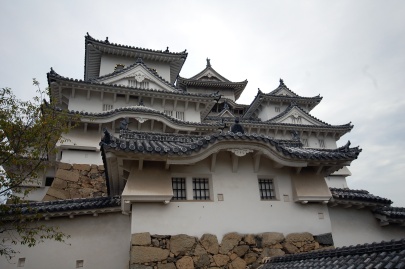
Beside all the temples and gardens in Kyoto, it also has a rather famous castle – Nijo-jo. Himeji, an hour west of Kyoto is best known for its castle Himeji-jo. Today (perhaps rather ambitiously) we visited both of them, so it’s only natural that I try and determine whose castle reigns supreme.
Round One – Accessibility
Nijo-jo: Kyoto’s a sprawling city, and unlike most of the other places we’ve stayed, there’s not one dominant mode of transport. We still haven’t really got a clue about which buses run where, so we opted to get a train, not realising that it may have been quicker just to walk. Turns out there’s a subway stop right outside the castle. So pretty easy to get to indeed, just don’t follow us there.
Himeji-jo: We jumped on the first train to Himeji when we reached Kyoto station, assuming a “Super Express” as it was called, would get us there pretty quickly. After being so used to Shinkansens getting you to your destination before you’ve left (or so it seems), sitting on a normal train for an hour and a half was quite a come down. Once in Himeji though, it’s a 10 minute stroll up the main street to the castle (and there’s no worrying about which way to go, you can see the castle before you even get off the train).
Winner: Himeji-jo. Assuming you knew what you were doing I would have declared this round a draw. However Himeji-jo gets bonus points for having free rental bikes from the station’s information centre, providing you get there early enough to nab one.
Round Two – Artistic Merit
Nijo-jo: The palace within Nijo-jo contains intricately carved wood panelling, and walls covered in paintings from the 1600s. It’s only after reading through the tourist brochures that you discover that some of the paintings you’re looking at are actually reproductions, but a collection of the originals are on display in a separate area.
Himeji-jo: The main tower of Himeji-jo does contain a limited collection of artworks, but most people are too busy climbing the stairs to get the top of the six floors to bother giving them more than a cursory glance.
Winner: Nijo-jo.
Round Three – Wow Factor
Nijo-jo: Everything you read about Nijo-jo mentions the nightingale floors, which are floor boards that make a sound (like a nightingale’s song) as you step on them, so that no one could sneak in without being heard. Kinda cool, but nothing too impressive. Until you hear them. It’s not like any other sound you’ve heard a floor board make – a creaky old house this is not. However that’s really the only part of the palace you get to experience first hand. All the rooms are roped off and closely guarded, no photos are allowed – it’s very much a look but don’t touch experience.
Himeji-ji: Towering over everything else in the area, it’s hard not be impressed with the mere sight of the six stories of the bright white building. Then you get inside and start climbing up. And up. I have no idea how fully armoured warriors would actually navigate the steep stairs, it was hard enough with a backpack. You’re free to wander around all the interior areas, with very few parts off-limits. When you finally reach the top there’s an amazing view as pay off for the climb.
Winner: Himeji-jo.
Round Four – Cultural Significance
Winner: Draw. Both are World Heritage Listed.
Round Five – Least Annoying Tour Groups
Winner: Himeji-jo. But perhaps that’s because we went at the end of the day and they’d all left. That’s one piece of advice I’d offer about visiting these sort of places – don’t try and beat the crowds, you’ll never win. We turned up at Nijo-jo just after opening and there were already ten empty tour buses out the front.
Anyway I could go on, but Himeji-jo is the clear victor in my books. Sure if you’ve got time do both, but if you have to choose I’d suggest you make it Himeji-jo.